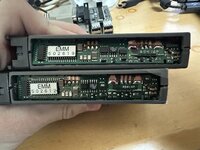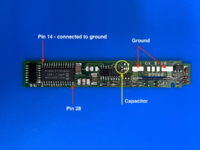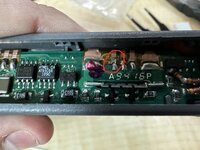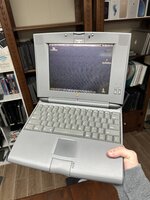3lectr1cPPC
Well-known member
I tried to rebuild two PowerBook 500 Series batteries. What could go wrong?
Well, I didn't light anything on fire which is a good start, but I don't have working batteries either.
I used pre-built 8-cell AA NiMH packs that @jmacz already used successfully on his own rebuilds.
Both batteries register proper voltage on the + and - terminals now, but neither of the EMM boards (Energy Monitoring Module, early complex "smart" BMS) in the batteries want to come online and talk to the computer. The computer will run off of the batteries if I unplug it, but it does not detect that a battery is in the computer. This means that Mac OS will put the computer to sleep as soon as it is able to. I cannot cold-start off of the batteries. If I lock up the system so Mac OS cannot put the computer into sleep mode, it will stay powered off the batteries, but I cannot recharge them in their current state.
Background on the batteries:
Both are the earlier of the two main revisions of these batteries (large internal ribbon cable). They came out of a PowerBook 540 that I got around August 2022. When I got the batteries, they did not show external corrosion at all, and were detected by the computer. I ran the three programs mentioned earlier and they also saw the batteries and ran tests. I remember both Lind and EMMpathy found errors that were able to be corrected in both batteries. At that point, both EMM boards tested 100% fine in all three tools, but the original cells were too tired to run the computer. A couple months after this, I cracked the cases open on both batteries in order to remove the original cells.
One of the EMM boards was perfect, and the second was was nearly perfect, with the only damage being some corrosion around the + battery connection on the internal ribbon, and a partial tear in the same area. It still has continuity.
After cell removal, the EMM boards sat around for over a year before I attempted the rebuild.
Diagnostic tests:
Lind BU500 - Fails to detect the battery.
EMMpathy - Fails to detect the battery.
Apple Intelligent Battery Update - Detects the battery, immediately throws an error that it cannot be updated.
Tests to the EMM boards:
Battery 1:
Battery Negative and the pin two to the right of it registers 5V, suggests the EMM board is receiving power and is exhibiting normal behavior.
Battery 2:
Same pin registers nothing, indicating the EMM is seemingly dead. Path from external contacts to the EMM board itself have continuity (in both batteries as well).
@jmacz had this same non-detected issue that turned out to be an EMM fault, apparantly with the Apple chip. Pin 28 (bottom right) was shorted to battery negative/ground. Neither of mine have pin 28 shorted to ground.
Other variables:
I have not replaced the one cap between the battery bays that I believe might have something to do with the batteries. Could this cap being bad cause non-detection? I'll bet said cap is on its way out in both my laptops.
My power supply situation is weird. I have my custom-built adapter, which only powers the computer. VBATT for battery charge is not connected as it requires a regulated 2A supply. I do have another OEM charger that's been recapped, but it's still faulty. On that one, VBATT works perfectly, but VMAIN will drop from 16V down to under 5V after around a minute of operation, and a quiet buzzing noise will begin coming from the supply. I figured that I could probably charge the batteries with the OEM supply until I get a better solution, but I can't do that without getting the computer to recognize the batteries. In the short time where VMAIN is working on the OEM charger, I still get the same results with non-detection.
Anyone know where to even start looking for faults? Finding working EMM boards isn't exactly trivial nowadays with battery corrosion at play...
Well, I didn't light anything on fire which is a good start, but I don't have working batteries either.
I used pre-built 8-cell AA NiMH packs that @jmacz already used successfully on his own rebuilds.
Both batteries register proper voltage on the + and - terminals now, but neither of the EMM boards (Energy Monitoring Module, early complex "smart" BMS) in the batteries want to come online and talk to the computer. The computer will run off of the batteries if I unplug it, but it does not detect that a battery is in the computer. This means that Mac OS will put the computer to sleep as soon as it is able to. I cannot cold-start off of the batteries. If I lock up the system so Mac OS cannot put the computer into sleep mode, it will stay powered off the batteries, but I cannot recharge them in their current state.
Background on the batteries:
Both are the earlier of the two main revisions of these batteries (large internal ribbon cable). They came out of a PowerBook 540 that I got around August 2022. When I got the batteries, they did not show external corrosion at all, and were detected by the computer. I ran the three programs mentioned earlier and they also saw the batteries and ran tests. I remember both Lind and EMMpathy found errors that were able to be corrected in both batteries. At that point, both EMM boards tested 100% fine in all three tools, but the original cells were too tired to run the computer. A couple months after this, I cracked the cases open on both batteries in order to remove the original cells.
One of the EMM boards was perfect, and the second was was nearly perfect, with the only damage being some corrosion around the + battery connection on the internal ribbon, and a partial tear in the same area. It still has continuity.
After cell removal, the EMM boards sat around for over a year before I attempted the rebuild.
Diagnostic tests:
Lind BU500 - Fails to detect the battery.
EMMpathy - Fails to detect the battery.
Apple Intelligent Battery Update - Detects the battery, immediately throws an error that it cannot be updated.
Tests to the EMM boards:
Battery 1:
Battery Negative and the pin two to the right of it registers 5V, suggests the EMM board is receiving power and is exhibiting normal behavior.
Battery 2:
Same pin registers nothing, indicating the EMM is seemingly dead. Path from external contacts to the EMM board itself have continuity (in both batteries as well).
@jmacz had this same non-detected issue that turned out to be an EMM fault, apparantly with the Apple chip. Pin 28 (bottom right) was shorted to battery negative/ground. Neither of mine have pin 28 shorted to ground.
Other variables:
I have not replaced the one cap between the battery bays that I believe might have something to do with the batteries. Could this cap being bad cause non-detection? I'll bet said cap is on its way out in both my laptops.
My power supply situation is weird. I have my custom-built adapter, which only powers the computer. VBATT for battery charge is not connected as it requires a regulated 2A supply. I do have another OEM charger that's been recapped, but it's still faulty. On that one, VBATT works perfectly, but VMAIN will drop from 16V down to under 5V after around a minute of operation, and a quiet buzzing noise will begin coming from the supply. I figured that I could probably charge the batteries with the OEM supply until I get a better solution, but I can't do that without getting the computer to recognize the batteries. In the short time where VMAIN is working on the OEM charger, I still get the same results with non-detection.
Anyone know where to even start looking for faults? Finding working EMM boards isn't exactly trivial nowadays with battery corrosion at play...
Last edited:





